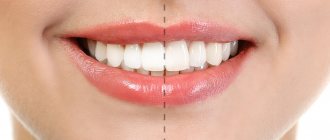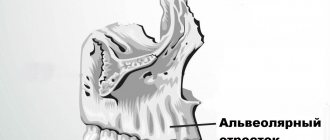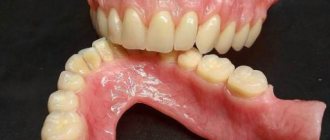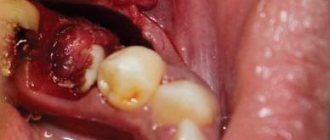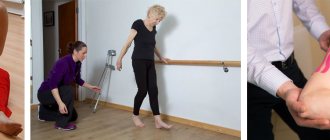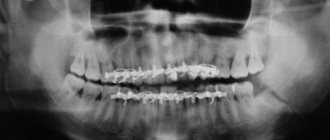16882
Malocclusion is a fairly common phenomenon that can be confidently interpreted as a diagnosis.
These are not only external defects of the maxillofacial apparatus, but also pathologies that cause certain harm to human health.
At the same time, there are often cases when the harm goes beyond the dental framework - difficulty chewing food leads to dysfunction of the gastric system.
One of these bite deviations is a pronounced defect in the development of the jaw. It manifests itself both in its size and in insufficient width or fragmented crowding of the dentition.
Definition
The concept of “small lower jaw” in orthodontics is not clearly defined.
This diagnosis is classified into several types, differing in the clinical picture of the anomaly.
Micrognathia
Mandibular micrognathia is a defective or too long-term development of an organ that goes beyond the norm.
The defect can affect both the entire jaw and its individual areas, for example, affecting only one lateral part.
Prognathia
It is considered a phenomenon directly opposite to the case described above.
The organ corresponds to the normal parameters, but with the pronounced size of the upper jaw, it seems that it is too small.
Experts often call this disease false prognathia.
Signs
The main sign indicating the presence of this disease is the visual observability of an anomaly - such a defect is visible to the naked eye, and you do not need to be a specialist in orthodontics to determine such a deviation in a person.
In addition, pathology deforms the natural proportions of the maxillofacial apparatus. The chin becomes sharp and slightly raised upward. Doctors even defined this phenomenon as “bird beard.”
It is important to understand that this is not just a cosmetic defect; micrognathia threatens its “owner” with the development of the pathology of tongue retraction, which is considered a serious disease.
The anomaly causes frequent uncontrollable attacks of suffocation and poses a serious threat to the patient's life.
The disease is often diagnosed based on this characteristic feature - excessive retraction of the chin leads to wrinkling of the skin in its area, and the horizontal fold between the chin and lip is smoothed out.
In addition, underdevelopment of the lower jaw often goes hand in hand with chromosomal mutation processes, which leads to Patau syndrome.
A clear sign indicating the presence of this defect is also the incorrect location of individual fragments of the dentition.
In the case when some organs are missing, neighboring teeth change the direction of growth, trying to spontaneously fill the free space.
How safe is an X-ray of a child's jaw?
X-rays of the jaw for children, including infants, are a relatively safe procedure. The radiation exposure during imaging is negligible and cannot negatively affect the further development of the dental system. At the same time, it must be said that taking X-rays without indications, for prevention, is still not worth it.
Contraindications for
Contraindications to X-raying a child’s jaw are:
- unsatisfactory general condition of the child;
- bleeding;
- pathologies in the thyroid gland.
Causes
This type of anomaly can be triggered by the following factors, some of which are external, and some are internal:
- unbalanced diet of a woman during pregnancy - in this situation, the defect is formed already at the stage of intrauterine development of the fetus;
- chromosomal mutations that cause deviations in the normal growth and development of the baby during pregnancy;
- genetic predisposition;
- Robin's syndrome is a congenital anomaly of the anatomical structure of the facial apparatus;
- too early loss of baby teeth or permanent organs in adulthood , as well as a fairly long change from a temporary bite to a permanent one;
- difficulty breathing through the nose , associated with the structure of the nasal septum or chronic diseases of the nasopharynx;
- mechanical organ injury.
Everything about correct orthognathic occlusion, its signs and characteristics.
Let's talk here about the treatment of dental dystopia.
Follow the link https://orto-info.ru/zubocheliustnye-anomalii/okklyuzii/glubokiy-prikus.html if you are interested in methods of treating deep bites in adults and children.
X-ray of the jaw in children
Problems with teeth, as well as with the development of bite, begin to bother a person from a very early age. Pediatricians constantly monitor the teething process in very young children. Parents can also seek advice from pediatric dentists if there is a suspicion that something is going wrong.
A procedure such as an x-ray of a child’s jaw is prescribed quite often today. There is no need to be afraid that X-rays can negatively affect the child’s health - the modern equipment used for the study is characterized by minimal radiation exposure. X-ray can be considered a safe diagnostic method.
Treatment
Methods for eliminating micrognathia depend on the degree of development of the pathology, the age of the patient and can be gentle or radical.
In the first case, treatment is carried out gradually through the use of special bite-leveling structures, and in the second, surgeons are involved in the work.
In children
In childhood, this deviation is easy and in most cases, successfully, treated mainly with therapeutic methods, and with rare exceptions, surgically:
- sanitation of the oral cavity – complete restoration of damaged tooth segments, as well as removal of affected root areas. Restoring the integrity of periodontal tissues using general and targeted spectrum agents;
- pediatric prosthetics – indicated for early loss of mammary organs. The voids are filled by splinting or attaching temporary devices that maintain the correct position of growing teeth and correct the size of the jaw arch;
- correction of language function and normalization of the respiratory system - in the first case, this is surgical cutting of the frenulum, which is done quickly and almost painlessly. In the second - surgical alignment of the partitions, followed by rehabilitation exercises;
- myogymnastics – tonic effect on the muscle tissue of the organ through special gymnastic exercises.
It is advisable to carry out with children 4–6 years of age, when in case of underdeveloped pathology this method can be used as the main method of treating the defect.With positive dynamics, the need for subsequent installation of orthopedic structures, as a rule, no longer arises;
- leveling the unevenness of the chewing surface using the method of grinding (fissures) - an ideal solution for a slight deviation in jaw closure;
- the use of leveling systems and structures is carried out when the anomaly is too pronounced, when other correction methods are ineffective. Wearing mouth guards and plates, and in infancy special nipples, gradually brings the deviation back to normal.
In adults
Treatment of patients whose bite has already been formed takes longer, and methods for correcting it are most often more radical.
Bone grafting
The essence of the method comes down to artificial extension using a graft. Bone tissue is taken from other areas of the patient’s tissue, which guarantees good survival of the material.
Fixation of the grafted fragments is carried out using screws made of high-quality, durable alloy of titanium components. This is done as follows:
- the lower organ is incised;
- the hard tissue is moved apart and the osteoplast is immersed inside;
- fixed with screws;
- intermediate voids are filled with special plastic chips;
- implantation of the membrane and suturing of the organ.
The main advantages of the method are the rapid survival rate and reliability of the procedure; the jaw augmented in this way retains its functionality for many years.
Disadvantage: individual intolerance to components and osteoplast fixatives.
In the video, watch the process of bone grafting for anomalies of the lower jaw.
Bone grafting plus liposculpture
Plastic surgery of hard bone tissue is carried out similarly to the option described above, with the difference that in parallel, aspiration of the local accumulation of fatty tissue is carried out using a vacuum method.
The technique qualitatively solves the aesthetic problem of underdeveloped chin caused by this pathology, corrects its shape, evens out the oval of the face and, in a sense, resembles the effect obtained from lifting the chin area.
The advantage is a high aesthetic result, the disadvantage is the high cost of the procedure and the presence of a large number of contraindications to its implementation.
Causes of open bite development and its dangerous consequences.
In this article we will discuss treatment methods for microdentia.
At this address https://orto-info.ru/zubocheliustnye-anomalii/ryadov/suzhenie.html we offer details about the treatment of narrowing of the dentition.
Endoprosthetics
It is made with harmless facial implants from non-biological components - silicone, porous polyethylene or cartilage extract. The desired shape is given to the device directly during the operation.
The implant is inserted through deep incisions in the mucous cavity, which leaves no postoperative traces. The product is inserted into the subperiosteum in lateral fragments into the chin area and attached to it with surgical sutures to fix its position.
The disadvantage of this method is the rather long recovery period.
Lipofilling
This option is considered to be a non-surgical correction, which is its main advantage.
The method allows you to give the chin the desired shape through pinpoint needle injection of fat cells into the subcutaneous area, in those areas where an increase in the size of the chin is required.
The entire procedure takes no more than an hour. The rehabilitation period passes quickly and without complications. The only drawback is that 30% of the implanted tissue fragments are rejected by the body, which requires repeated lipofilling 5-6 months after the first procedure.
To learn how chin augmentation is performed using lipofilling, watch the video.
Methodology
There are several ways to take an X-ray of a child's jaw or lower skull.
Intraoral radiography
Intraoral x-rays are carried out using special dental devices, which help take targeted images of one or more adjacent teeth (one to four). Such an examination allows us to assess the condition of the hard tissues of primary and permanent teeth, periodontal and periodontal tissues, jaw bones for the diagnosis of retention and follicular cysts, oncological tumors, anomalies in the location and number of erupted teeth and rudiments, etc.
When performing a study, a blank of x-ray film is placed in a special paper envelope, which is inserted into the oral cavity and placed in the area of the desired tooth. The X-ray machine is brought to the face from the outside and placed as close as possible to the tooth/teeth being examined.
In pediatric dentistry, intraoral radiography is often prescribed to diagnose pathologies of the palatal suture. Although, it must be said that if we are talking about a very young patient (2-3 years), it is quite difficult to carry out such an x-ray, because it can be difficult to explain to a child why it is needed and that it will not hurt.
Extraoral methods
The most common method of performing extraoral x-rays is a panoramic photograph, or orthopantomogram. In such photographs, you can see in a direct projection the entire upper and lower dentition, as well as the structure of the patient’s jaw. Orthopantomogram images allow you to make a detailed interpretation and description of the condition of teeth and gums, to recognize even hidden pathologies or those that have just begun to develop (for example, periodontal disease, caries).
You can see what a panoramic x-ray of a child’s jaw looks like in a photo on the Internet.
Prices
The approximate cost of treating a defect of abnormal development of the lower jaw is given in the table:
| Character of the bite | Correction method | Average price (in rubles) |
| Lactic | Sanitation of the oral cavity | From 3 500 |
| Lactic | Orthopedic therapy | From 30 000 |
| Lactic | Fissure grinding | From 11 000 |
| Lactic | Operation | From 15 000 |
| Constant | Bone grafting | From 19 000 |
| Constant | Bone grafting pole liposculpture | From 50 000 |
| Constant | Endoprosthetics | From 40 000 |
| Constant | Lipofilign | From 35 000 |
Prevention
In some cases, the development of such a defect can be completely avoided by following the following recommendations:
- preference should be given to breastfeeding , and if this is not possible, control the hole on the nipple - it should not be large in size;
- it is necessary to choose the right pacifier so that its position does not put constant pressure on the weak bone tissue of the gums;
- timely treatment of dental diseases.
Diagnosis and treatment of narrow jaw
Deformed dentition, crowded teeth, malocclusion, unerupted teeth are consequences of an underdeveloped dental system. The earlier these abnormalities are diagnosed, the more effective the treatment will be. To expand the lower and upper jaws, therapeutic methods, mechanical expanders and plates are used. In rare cases, only surgery helps.
In children under 10-11 years old, jaw expansion gives the best results. This is a time of active growth and formation of bone tissue, so the defect can be corrected with the help of orthodontic structures.


